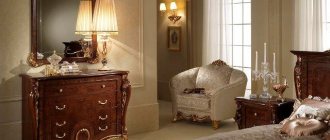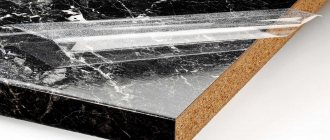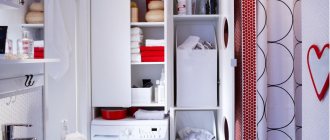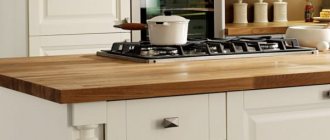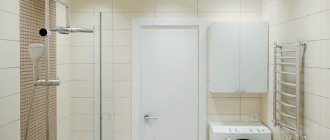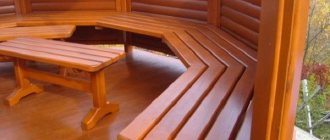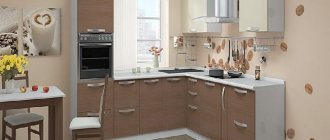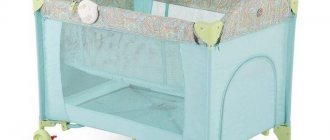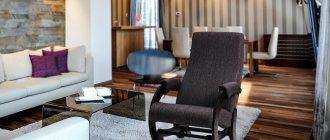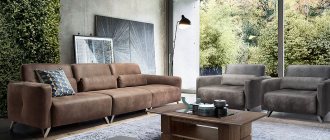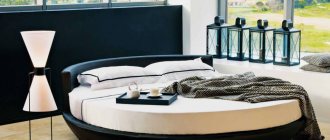A large number of different materials are used to make furniture. One of the most common materials is chipboard. It is especially often used in the production of cabinet furniture, tables, sofas, beds and much more.
Despite the fact that the first versions of this material appeared at the beginning of the 20th century, the domestic consumer has a vague idea of what kind of material it is, what it is made of, and what its advantages and disadvantages are. Many simply cannot decipher the abbreviation of the name of the material. This article will help you understand all these points.
What is chipboard?
The name of this material is nothing more than an abbreviation. LDSP stands for laminated particle board.
The transcript gives a good idea of what this material is all about. It is based on natural ingredients and small waste from the woodworking industry. The appearance of this material made it possible to reduce waste in the manufacture of wooden products from 60% to 10%.
The board is made from large wood chips. Hot pressing is used to obtain a strong structure. Formaldehyde resins are used for connection. Laminated film of various colors and shades is used as the top layer.
Main types of chipboard
Chipboard is usually classified according to several criteria. Depending on the formaldehyde emission, chipboard is assigned class E1 or E2. The first one complies with Russian GOST 10632-89 and is more environmentally friendly. Class E2 cannot be used to produce products for children; some European manufacturers have long abandoned the production of this type of board.
Based on the appearance of the finished product, chipboard can be divided into three types:
- 1st grade. For its production, only high-quality raw materials without foreign additives are used. Sawdust from one type of tree is often used. The resulting product is smooth, with minimal defects and without chips. Such a slab must be finished with veneer or film on both sides.
- 2nd grade. During manufacturing, minor chips and scratches are allowed. This type of slab may be without cladding.
- 3rd grade. The final product has significant defects (with scratches, cracks and chips). Used for construction and never covered.
Depending on the type of cladding, chipboard can be distinguished:
- rough (without facing material);
- laminated (coating is applied in the form of a melamine film, or a resistant varnish);
- veneered (the cladding is made of a thin sheet of natural wood.
To better understand the advantages and disadvantages of chipboard and laminated chipboard, you need to understand their characteristics in more detail.
Compatibility with other materials
Laminated chipboard is a universal material used for the production of all types of furniture: cabinets, walls, hallways, kitchens. It has a pleasant appearance and laconicism, which allows it to be combined with completely different types of materials. Most often, laminated chipboard complements MDF, from which facades are made, and fiberboard, presented in the form of the back wall of the product.
In the production of cabinets, the most relevant additions are in the form of large mirror panels, emphasizing the elegance and beauty of modern furniture.
Often cabinets are supplemented with plastic panels with various designs applied through photo printing.
Laminated chipboard looks great in tandem with glass display cases, which can be presented in the form of transparent, frosted or shaded glass.
How is it different from chipboard?
Chipboard is the predecessor of laminated chipboard.
These materials have at least small but significant differences:
- Moisture resistant. If laminated chipboard is at least somehow protected from swelling through the use of laminated film, then an untreated board is defenseless against moisture. Laminated boards are also less susceptible to mold and mildew.
- Application area. Laminated board has many more applications in production due to the large number of types of film. Products made from it can fit into any interior of an apartment or house.
- Price. It is logical that a more technically complex product costs more. Lamination makes the production of laminated chipboard more expensive, so it costs more than an untreated board.
Advantages and disadvantages of laminated chipboard
Like any material, laminated chipboard has its advantages and disadvantages. Only taking into account all factors will allow you to make a choice in favor of this material or refuse it.
Advantages:
- Variety of colors. You can easily order furniture from any color with a large number of shades. There is also a wide variety of wood colors available.
- Low price. Compared to other materials, such as solid wood or MDF, it is not very expensive. This is due to the low cost of the components used to produce the board. The production process is also inexpensive.
- Reliable structure. The material withstands the mechanical effects of external factors and temperature changes quite well.
- Good thermal insulation and noise absorption properties.
Flaws:
- Exposure to moisture. It is a widely known fact that laminated chipboard does not tolerate exposure to a humid environment. With constant interaction with moisture, the volume of wood shavings can increase by up to 30%, which leads to swelling of the slab and a breakdown in its strength. Using a moisture-resistant version of laminated chipboard partially reduces the likelihood of damage to the slab, however, it will not be possible to completely get rid of the effects of moisture.
- Evaporation. The use of formaldehyde resins for the manufacture of chipboards leads over time to the formation of formaldehyde, which evaporates from the board. This substance is harmful to the environment as well as human health. To be fair, it should be noted that the use of laminated film reduces the amount of evaporation to a minimum.
- Repeatedly screwing self-tapping screws into the same place reduces the possibility of attaching them to the chipboard, and the board begins to crumble. Because of this, laminated chipboard cannot be milled and created curved contours.
Tips for choosing
When choosing laminated chipboard, you need to remember that the material has a laminating film that reliably hides its internal composition. In order not to fall into illiquid goods hidden under a shiny shell, when choosing, you need to know the criteria for evaluating the material. Not all types of slabs are suitable for making furniture. Therefore, when choosing a material, you need to use the following knowledge about assessing product quality:
- no need to buy material at prices lower than analogues. There is definitely a reason for this: the price is reduced due to a promotion to attract the attention of customers in order to increase consumer demand;
- a defective product is offered without explanation for a price reduction (such a product is suitable for construction work), but not for the manufacture of high-quality cabinet furniture;
- the decorative film should not have scratches or cracks;
The main advantage of laminated chipboard is its protection from aggressive environmental influences: high humidity, the influence of pathogens and fungi, rotting, high resistance to temperature influences, long service life. If the choice is made carelessly and the material has flaws, the protective properties of the material will be impaired over time. This will lead to a reduction in service life and disappointment in the purchase.
Where is it used?
Laminated chipboard is widely used in the furniture industry. This material is practically irreplaceable in the manufacture of cabinet furniture. Budget options for kitchen furniture can consist entirely of chipboard. Often this material is combined with more expensive MDF. Cabinets of various models are also made from laminated chipboard.
Many interior elements of an apartment or house are also made using laminated chipboard. Beds, sofas, hangers and many other furniture contain laminated chipboard parts in their design. It is also used:
- for the construction of decorative partitions;
- wall and door cladding;
- as load-bearing structural elements;
- for the construction of a rough field;
- as a working surface for bar counters and kitchen countertops.
Attention! When making children's furniture yourself or when purchasing it in a store, you must make sure that it has class E1 and has the necessary certificate of conformity, since chipboard of a lower class can harm the health of the child.
You can see how to paint laminated chipboard on furniture in the interior of an apartment in combination with the color of the walls and floor in this designer.
Color spectrum
Chipboards are a fertile material from which furniture production masters create works of art. There are collections of laminated chipboard decors based on a wide range of colors. Manufacturing furniture using design ideas makes LDPS an even more popular type of material. The variety of color solutions is divided into groups:
- surfaces of slabs decorated with patterns and designs of extraordinary colors;
- slabs decorated with veneer of various types of trees and flowers;
- glossy decor options;
- coatings that imitate rare types of wood: “Cordoba” look interesting and natural;
- "merano";
- Winchester oak.
- cherries;
- aluminum;
- blue;
The first three groups of colors, taking into account the complexity of the work and the price of the material, are used only for the facade.
Edging laminated chipboard
All furniture parts must be processed in accordance with technical and sanitary standards. For laminated chipboards, there is a rule according to which it is mandatory to use an edge to process the ends of the part. The edge can be made of ABS, melamine, but most often you can find PVC. Its thickness can vary from 0.4 to 2 mm. Occasionally you can find veneer.
Why this particular material? The use of PVC edges is subject to compliance with all sanitary and hygienic standards. It is also resistant to mechanical stress, wear resistance is much higher than that of analogues. The advantages of this material include its low price, especially if the country of origin is China.
Is it necessary to edge chipboard? Of course, otherwise you may encounter glue fumes from the inside of the slab, which can harm the body. The PVC edge blocks this process, thereby preserving the health of those around you.
Dimensions and thickness of sheets
There is no single standard that manufacturers adhere to when determining the dimensions of a sheet of laminated chipboard. Both width and length, as well as thickness, vary significantly. If thickness has some specific variations, then with length and width there is a huge variety of sizes.
The width and length vary greatly among each manufacturer.
| Length, mm | Width, mm |
| 1830 2440 2750 3500 3660 5500 | 1220 1500 1750 1830 |
Typically, manufacturers produce sheets with a thickness of 8 to 38 mm.
Sheet thickness depending on use:
| Thickness, mm | Scope of application |
| 8 | It is used for lining doors, decorative parts, walls, as well as for the manufacture of boxes and packaging for transportation and as the bottom of a box |
| 16 | Used in the production of furniture products, for the construction of partitions and subfloors |
| 18 | Necessary for creating cabinet furniture and for the base of floor coverings |
| 20 | Needed for building a subfloor |
| 22 | Used for making tables, chairs, kitchen sets and kitchens |
| 25 | Used for the production of countertops, window sills, doors and load-bearing structural elements |
| 32 | Used for the same purposes as a 25 mm plate, but designed for a more severe load |
| 38 | Needed for the construction of bar counters and kitchen countertops |
What is better for furniture: MDF or chipboard?
For the manufacture of furniture, the two main materials most often used are chipboard and MDF. How to understand which one is better for furniture?
There are fundamental differences between them:
- Laminated chipboard is made from wood sawdust and shavings; formaldehyde acts as a binder.
- During the production of MDF, wood dust from waste from the wood processing industry, crushed to a fine fraction, is used as a raw material. The binding elements are environmentally friendly paraffin and ligin. Thanks to this, MDF is much more environmentally friendly than laminated chipboard. It is safe to use in children's rooms.
Paraffin in MDF serves not only as an environmentally friendly binding agent, but also as an excellent water-repellent material, so it is not necessary to treat it with different impregnations.
Each of them has properties that are better suited in a particular situation:
- Density. MDF is much denser due to its structure, so it holds fasteners much better. It is good to use as kitchen cabinet fronts. The density also allows you to mill MDF, which is not possible with laminated chipboard.
- Constructive capabilities. The structural features of the material make it possible to use MDF in complex structures; the variable capabilities of this material are much higher compared to laminated chipboard.
- Price. Laminated chipboard is much cheaper compared to MDF, so it is used for the manufacture of economy-class furniture.
- Humidity. Laminated chipboard is much less resistant to moisture than MDF.
- Harmful to health. The evaporation of formaldehyde from laminated chipboard is harmful to human health, but not from MDF.
- Colors. Today on the market you can find a huge variety of chipboard colors, both to match the structure of the wood, and a large number of solid colors. The structure of the coating can be either glossy or matte. MDF does not have such a large selection of decorative coatings as laminated chipboard.
Color options
A wide palette of possible colors of laminated chipboard allows you to bring any design ideas to life. Furniture is available in cold, warm shades, light, dark colors. White, beige cabinets, tables, chests of drawers are optimal for small spaces. They make the room visually lighter and more spacious. Black, gray, brown products are recommended to be used in styles such as classic, modern, and empire.
It is important to immediately determine which color will suit the existing interior, because changing the cladding of finished furniture is extremely difficult. Chipboards do not have to be plain. They can repeat the texture of other materials or be decorated with different decorative elements. Especially in demand:
- surfaces with patterns and designs;
- slabs lined with oak, alder, pine and other trees;
- glossy coatings.
Assortment of glass furniture, its pros and cons, processing features
After special treatment, chipboard can outwardly resemble rare wood species, for example, repeating the color of Winchester oak. It can be difficult for the average person to distinguish a budget cabinet from an expensive product.
2021 trends for chipboard
The colors of laminated chipboards change annually; this year there are four trends.
- Organic. In this direction, colors like natural wood and rough stone are collected. They give peace and serenity when arranging any design.
- Expressive. Contains colors that reflect imperfections in the wood structure, such as knots and abrasions in the wood. In this range of colors you can find marble in dark gray shades with veins. This direction is associated with wealth and prosperity.
- Industrial. This collection helps define the harmony and chic of interior design. Here are light shades of decorative stone, wood-gray geometric patterns and much more.
- Avant-grade. This style suggests combining opposites. From sophisticated and gentle to bold and defiant. Here you can find modern monochrome colors and shiny aluminum shades.
Manufacturers overview:
There are a large number of companies in the world producing laminated chipboards. Both foreign and domestic manufacturers are successful in Russia. Let's look at the most popular manufacturers of laminated boards today.
Egger
The Austrian company Egger is one of the leaders in the production of chipboards. It was founded in 1961 and began as a family business, but is now a company with extensive production capacity across seven factories in Europe. One of them operates in Russia.
It produces high-quality products that collect only positive consumer reviews. It meets all European quality standards. This confirms the annually growing demand for products. A huge number of color options are constantly appearing.
Kronospan
Kronospan is a company founded in the 19th century in Austria. Operates in 24 countries around the world.
The products of this plant are distinguished by increased moisture resistance, quality, and antistatic characteristics. The products produced comply with all environmental requirements and are very diverse.
Lamartie
Despite the foreign name, Lamarty was founded and operates in Russia. Successfully competes with foreign analogues. For production, pine and birch shavings without foreign additives are used. The company has environmental certificates of product conformity, which means it produces laminated chipboard that is safe for health.
Since 2012, the plant’s product range has included laminated chipboard of class E 0.5, which meets all quality standards of the European Union.
A few final words
Making furniture requires not only sufficient experience, good tools and design, but also high-quality safe material. You can purchase high-quality laminated chipboard that meets all the requirements of European standards only from trusted manufacturers and suppliers. Foreign manufacturers offer high-quality material, but you should not overpay just for a well-known brand, because domestic companies produce laminated boards that are not inferior in characteristics to imported analogues, but are cheaper.
Save time: selected articles delivered to your inbox every week
